Related Research Articles

Radar is a system that uses radio waves to determine the distance (ranging), direction, and radial velocity of objects relative to the site. It is a radiodetermination method used to detect and track aircraft, ships, spacecraft, guided missiles, motor vehicles, map weather formations, and terrain.

The Type 23 frigate or Duke class is a class of frigates built for the United Kingdom's Royal Navy. The ships are named after British Dukes, thus leading to the class being commonly known as the Duke class. The first Type 23, HMS Norfolk, was commissioned in 1989, and the sixteenth, HMS St Albans was commissioned in June 2002. They form the core of the Royal Navy's destroyer and frigate fleet and serve alongside the Type 45 destroyers. They were designed for anti-submarine warfare, but have been used for a range of uses. Nine Type 23 frigates remain in service with the Royal Navy, with three vessels having been sold to the Chilean Navy and four being retired since 2021.

The Type 45 destroyer, also known as the D or Daring class, is a class of six guided-missile destroyers built for the United Kingdom's Royal Navy in the early 21st century. The class is primarily designed for anti-aircraft and anti-missile warfare and is built around the PAAMS air-defence system using the SAMPSON Active electronically scanned array (AESA) and the S1850M long-range radars. The first three destroyers were assembled by BAE Systems Surface Fleet Solutions from partially prefabricated "blocks" built at different shipyards; the remaining three were built by BAE Systems Maritime – Naval Ships. The first ship in the Daring class, HMS Daring, was launched on 1 February 2006 and commissioned on 23 July 2009.

The Westland Lynx is a British multi-purpose twin-engined military helicopter designed and built by Westland Helicopters at its factory in Yeovil. Originally intended as a utility craft for both civil and naval usage, military interest led to the development of both battlefield and naval variants. The Lynx went into operational usage in 1977 and was later adopted by the armed forces of over a dozen nations, primarily serving in the battlefield utility, anti-armour, search and rescue and anti-submarine warfare roles.
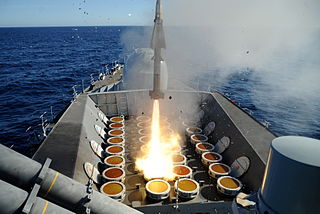
Sea Wolf is a naval surface-to-air missile system designed and built by BAC, later to become British Aerospace (BAe) Dynamics, and now MBDA. It is an automated point-defence weapon system designed as a short-range defence against both sea-skimming and high angle anti-ship missiles and aircraft. The Royal Navy has fielded two versions, the GWS-25 Conventionally Launched Sea Wolf (CLSW) and the GWS-26 Vertically Launched Sea Wolf (VLSW) forms. In Royal Navy service Sea Wolf is being replaced by Sea Ceptor.
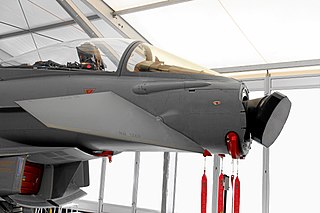
An active electronically scanned array (AESA) is a type of phased array antenna, which is a computer-controlled antenna array in which the beam of radio waves can be electronically steered to point in different directions without moving the antenna. In the AESA, each antenna element is connected to a small solid-state transmit/receive module (TRM) under the control of a computer, which performs the functions of a transmitter and/or receiver for the antenna. This contrasts with a passive electronically scanned array (PESA), in which all the antenna elements are connected to a single transmitter and/or receiver through phase shifters under the control of the computer. AESA's main use is in radar, and these are known as active phased array radar (APAR).

The BAe Sea Eagle is a medium-weight sea-skimming anti-ship missile designed and built by BAe Dynamics. It is designed to sink or disable ships up to the size of aircraft carriers in the face of jamming and other countermeasures including decoys. Its users include the Royal Air Force and Royal Navy, the Royal Saudi Air Force, and the Indian Navy.

The Sea Skua is a British lightweight short-range air-to-surface missile (ASM) designed for use from helicopters against ships. It was primarily used by the Royal Navy on the Westland Lynx. Although the missile is intended for helicopter use, Kuwait employs it in a shore battery and on their Umm Al Maradem fast attack craft.
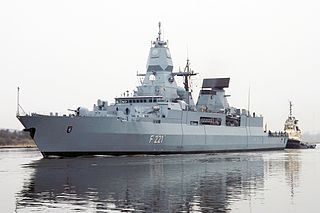
The F124 Sachsen class is the German Navy's latest class of air-defense frigates. The design of the Sachsen-class frigate is based on that of the F123 Brandenburg class but with enhanced stealth features designed to deceive an opponent's radar and acoustic sensors. The class incorporates an advanced multifunction radar APAR and a SMART-L long-range radar which is purported to be capable of detecting stealth aircraft and stealth missiles.
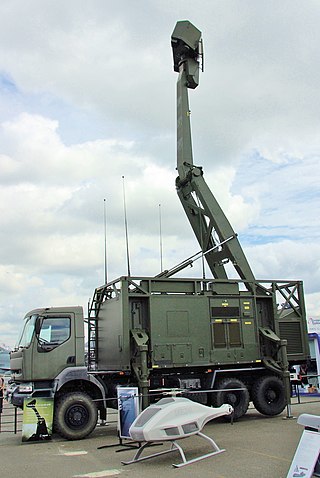
The Saab Giraffe Radar is a family of land and naval two- or three-dimensional G/H-band passive electronically scanned array radar-based surveillance and air defense command and control systems. It is tailored for operations with medium- and Short Range Air Defense (SHORAD) missile or gun systems, or for use as gap-fillers in a larger air defense system.

The AS.15 and AS.15TT are French anti-ship missiles. It was developed as a replacement for the AS-12 missile.

The AgustaWestland AW159 Wildcat is a military helicopter, developed by the British-Italian helicopter manufacturer AgustaWestland, and later marketed by the Italian aerospace company Leonardo. It is an improved version of the Westland Super Lynx designed to serve in the battlefield utility, search and rescue, aerial reconnaissance, anti-submarine warfare (ASW), anti-surface warfare (ASuW), utility, command and control, and troop transport duties.

The Ferranti Blue Fox was a British multi-role airborne radar designed and built for the Royal Navy by Ferranti Defence Systems in the late 1970s. It had a mixed record in service, and was replaced by the more capable Blue Vixen.

This is a list of Active Royal Navy weapon systems.

Sea Venom is an Anglo-French lightweight anti-ship missile developed by MBDA to equip the French Navy and the Royal Navy. The missile is known as Anti-Navire Léger (ANL) in France and Sea Venom in the United Kingdom. While initial operating capability had been expected with the Royal Navy in 2022, in 2023 it was reported that, due to "on-going integration challenges", the Royal Navy's Wildcat helicopters would only achieve full operating capability with the missile in 2026. The first test launch, from an AS365 Dauphin helicopter of the French DGA defence procurement agency, was successfully conducted on 21 June 2017.

The Visakhapatnam-class destroyers, also classified as the P-15 Bravo class, or simply P-15B, is a class of guided-missile destroyers currently being built for the Indian Navy. The Visakhapatnam class is an upgraded derivative of its predecessor, the Kolkata class, with improved features of stealth, automation and ordnance.
The Royal Navy's Type 901 X-band radar was used as the beam-riding command guidance system for the Seaslug missile system, which was the first such system used by the Royal Navy. Designed by the Admiralty Surface Radar Establishment at Portsdown, the project was passed to Marconi Systems for manufacture.
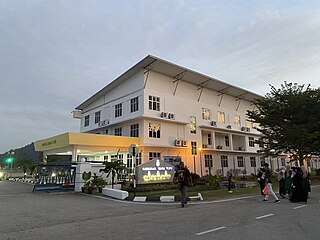
The Royal Malaysian Navy Aviation is the naval aviation branch of the Royal Malaysian Navy (RMN). RMN aviation also known as the KD Rajawali. It was based in Lumut, Perak and currently consisted of four squadron.
The Babur-class corvette, also known as the PN MILGEM class, is a class of four heavy corvettes under construction for the Pakistan Navy. This class is a subclass of the Turkish MILGEM project. The corvette class is heavier and larger than the Turkish Ada-class corvette and are also equipped with VLS.
References
- ↑ Flight Global 1991
- ↑ Flight Global July 2002
- ↑ "Seaspray 5000E multi-mode surveillance radar" (PDF). Archived from the original (PDF) on 10 June 2017.
- ↑ "Seaspray 7000E multi-mode surveillance radar" (PDF). Archived from the original (PDF) on 11 September 2018.
- ↑ "Seaspray 7500E V2 AESA surveillance radar" (PDF). Archived (PDF) from the original on 4 September 2021.